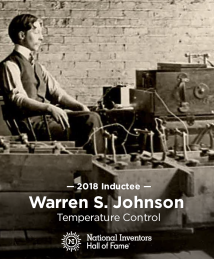Warren S. Johnson
Warren Johnson was born in 1847 in Leicester, Vermont, to homesteading farmers. Two years later, the family moved to Wisconsin, where the largely self-taught Johnson would become a pioneer of temperature regulation technologies. His innovations and the company he co-founded, Johnson Controls, helped launch the multi-billion-dollar building controls industry.
In 1876, Johnson began teaching at Whitewater Normal School, where classrooms were heated by basement hot air furnaces. The system yielded fluctuating classroom temperatures; hand-operated dampers located at the basement furnaces were the sole, inefficient means of adjustment. Each hour, a custodian entered classrooms to assess temperature, then opened or closed dampers as needed. The ongoing disruption spurred Johnson to develop a practical solution, leading to his 1883 patent for the electric room thermostat. This eliminated hourly interruptions, but still required manual intervention. Johnson improved the electric room thermostat by incorporating compressed air with electricity, which automated operation of the valves and dampers. In 1883, Johnson left teaching to concentrate fully on advancing his technology.
In 1895, Johnson introduced the first multizone automatic temperature control system commercially feasible for widespread application. The Johnson System of Temperature Regulation was used in commercial buildings, offices and schools, and also installed in the U.S. Capitol Building, the Smithsonian, the New York Stock Exchange, West Point Military Academy and the home of Andrew Carnegie. In 2008, it was designated an ASME Historic Mechanical Engineering Landmark.
Johnson also created and commercialized early steam-powered motor vehicles, experimented with wireless communications and designed large, pneumatic clock towers. He held over 50 U.S. patents.


